Khushbu Pahwa
Instruction-Tuned Video-Audio Models Elucidate Functional Specialization in the Brain
Jun 09, 2025Abstract:Recent voxel-wise multimodal brain encoding studies have shown that multimodal large language models (MLLMs) exhibit a higher degree of brain alignment compared to unimodal models in both unimodal and multimodal stimulus settings. More recently, instruction-tuned multimodal models have shown to generate task-specific representations that align strongly with brain activity. However, prior work evaluating the brain alignment of MLLMs has primarily focused on unimodal settings or relied on non-instruction-tuned multimodal models for multimodal stimuli. To address this gap, we investigated brain alignment, that is, measuring the degree of predictivity of neural activity recorded while participants were watching naturalistic movies (video along with audio) with representations derived from MLLMs. We utilized instruction-specific embeddings from six video and two audio instruction-tuned MLLMs. Experiments with 13 video task-specific instructions show that instruction-tuned video MLLMs significantly outperform non-instruction-tuned multimodal (by 15%) and unimodal models (by 20%). Our evaluation of MLLMs for both video and audio tasks using language-guided instructions shows clear disentanglement in task-specific representations from MLLMs, leading to precise differentiation of multimodal functional processing in the brain. We also find that MLLM layers align hierarchically with the brain, with early sensory areas showing strong alignment with early layers, while higher-level visual and language regions align more with middle to late layers. These findings provide clear evidence for the role of task-specific instructions in improving the alignment between brain activity and MLLMs, and open new avenues for mapping joint information processing in both the systems. We make the code publicly available [https://github.com/subbareddy248/mllm_videos].
Correlating instruction-tuning (in multimodal models) with vision-language processing (in the brain)
May 26, 2025Abstract:Transformer-based language models, though not explicitly trained to mimic brain recordings, have demonstrated surprising alignment with brain activity. Progress in these models-through increased size, instruction-tuning, and multimodality-has led to better representational alignment with neural data. Recently, a new class of instruction-tuned multimodal LLMs (MLLMs) have emerged, showing remarkable zero-shot capabilities in open-ended multimodal vision tasks. However, it is unknown whether MLLMs, when prompted with natural instructions, lead to better brain alignment and effectively capture instruction-specific representations. To address this, we first investigate brain alignment, i.e., measuring the degree of predictivity of neural visual activity using text output response embeddings from MLLMs as participants engage in watching natural scenes. Experiments with 10 different instructions show that MLLMs exhibit significantly better brain alignment than vision-only models and perform comparably to non-instruction-tuned multimodal models like CLIP. We also find that while these MLLMs are effective at generating high-quality responses suitable to the task-specific instructions, not all instructions are relevant for brain alignment. Further, by varying instructions, we make the MLLMs encode instruction-specific visual concepts related to the input image. This analysis shows that MLLMs effectively capture count-related and recognition-related concepts, demonstrating strong alignment with brain activity. Notably, the majority of the explained variance of the brain encoding models is shared between MLLM embeddings of image captioning and other instructions. These results suggest that enhancing MLLMs' ability to capture task-specific information could lead to better differentiation between various types of instructions, and thereby improving their precision in predicting brain responses.
* 30 pages, 22 figures, The Thirteenth International Conference on Learning Representations, ICLR-2025, Singapore. https://openreview.net/pdf?id=xkgfLXZ4e0
Multi-modal brain encoding models for multi-modal stimuli
May 26, 2025Abstract:Despite participants engaging in unimodal stimuli, such as watching images or silent videos, recent work has demonstrated that multi-modal Transformer models can predict visual brain activity impressively well, even with incongruent modality representations. This raises the question of how accurately these multi-modal models can predict brain activity when participants are engaged in multi-modal stimuli. As these models grow increasingly popular, their use in studying neural activity provides insights into how our brains respond to such multi-modal naturalistic stimuli, i.e., where it separates and integrates information across modalities through a hierarchy of early sensory regions to higher cognition. We investigate this question by using multiple unimodal and two types of multi-modal models-cross-modal and jointly pretrained-to determine which type of model is more relevant to fMRI brain activity when participants are engaged in watching movies. We observe that both types of multi-modal models show improved alignment in several language and visual regions. This study also helps in identifying which brain regions process unimodal versus multi-modal information. We further investigate the contribution of each modality to multi-modal alignment by carefully removing unimodal features one by one from multi-modal representations, and find that there is additional information beyond the unimodal embeddings that is processed in the visual and language regions. Based on this investigation, we find that while for cross-modal models, their brain alignment is partially attributed to the video modality; for jointly pretrained models, it is partially attributed to both the video and audio modalities. This serves as a strong motivation for the neuroscience community to investigate the interpretability of these models for deepening our understanding of multi-modal information processing in brain.
* 26 pages, 15 figures, The Thirteenth International Conference on Learning Representations, ICLR-2025, Singapore. https://openreview.net/pdf?id=0dELcFHig2
EpMAN: Episodic Memory AttentioN for Generalizing to Longer Contexts
Feb 20, 2025



Abstract:Recent advances in Large Language Models (LLMs) have yielded impressive successes on many language tasks. However, efficient processing of long contexts using LLMs remains a significant challenge. We introduce \textbf{EpMAN} -- a method for processing long contexts in an \textit{episodic memory} module while \textit{holistically attending to} semantically relevant context chunks. The output of \textit{episodic attention} is then used to reweigh the decoder's self-attention to the stored KV cache of the context during training and generation. When an LLM decoder is trained using \textbf{EpMAN}, its performance on multiple challenging single-hop long-context recall and question-answering benchmarks is found to be stronger and more robust across the range from 16k to 256k tokens than baseline decoders trained with self-attention, and popular retrieval-augmented generation frameworks.
Weighted Diversified Sampling for Efficient Data-Driven Single-Cell Gene-Gene Interaction Discovery
Oct 21, 2024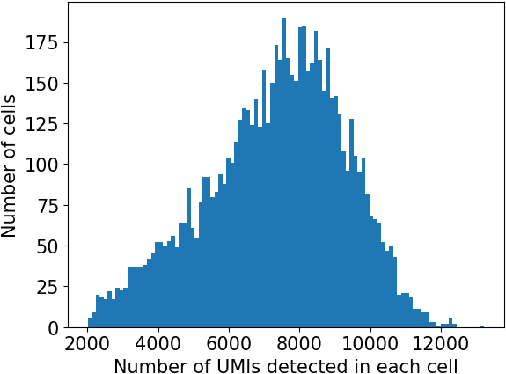
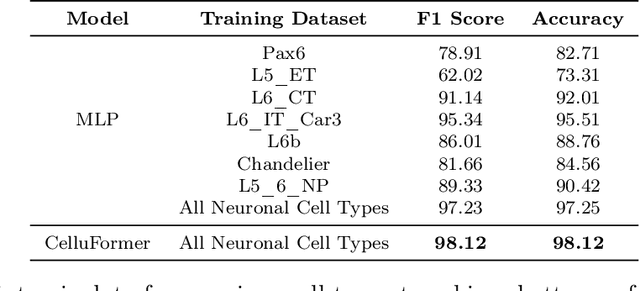


Abstract:Gene-gene interactions play a crucial role in the manifestation of complex human diseases. Uncovering significant gene-gene interactions is a challenging task. Here, we present an innovative approach utilizing data-driven computational tools, leveraging an advanced Transformer model, to unearth noteworthy gene-gene interactions. Despite the efficacy of Transformer models, their parameter intensity presents a bottleneck in data ingestion, hindering data efficiency. To mitigate this, we introduce a novel weighted diversified sampling algorithm. This algorithm computes the diversity score of each data sample in just two passes of the dataset, facilitating efficient subset generation for interaction discovery. Our extensive experimentation demonstrates that by sampling a mere 1\% of the single-cell dataset, we achieve performance comparable to that of utilizing the entire dataset.
InfiniBench: A Comprehensive Benchmark for Large Multimodal Models in Very Long Video Understanding
Jun 28, 2024Abstract:Understanding long videos, ranging from tens of minutes to several hours, presents unique challenges in video comprehension. Despite the increasing importance of long-form video content, existing benchmarks primarily focus on shorter clips. To address this gap, we introduce InfiniBench a comprehensive benchmark for very long video understanding which presents 1)The longest video duration, averaging 76.34 minutes; 2) The largest number of question-answer pairs, 108.2K; 3) Diversity in questions that examine nine different skills and include both multiple-choice questions and open-ended questions; 4) Humancentric, as the video sources come from movies and daily TV shows, with specific human-level question designs such as Movie Spoiler Questions that require critical thinking and comprehensive understanding. Using InfiniBench, we comprehensively evaluate existing Large MultiModality Models (LMMs) on each skill, including the commercial model Gemini 1.5 Flash and the open-source models. The evaluation shows significant challenges in our benchmark.Our results show that the best AI models such Gemini struggles to perform well with 42.72% average accuracy and 2.71 out of 5 average score. We hope this benchmark will stimulate the LMMs community towards long video and human-level understanding. Our benchmark can be accessed at https://vision-cair.github.io/InfiniBench/
GNNX-BENCH: Unravelling the Utility of Perturbation-based GNN Explainers through In-depth Benchmarking
Oct 03, 2023


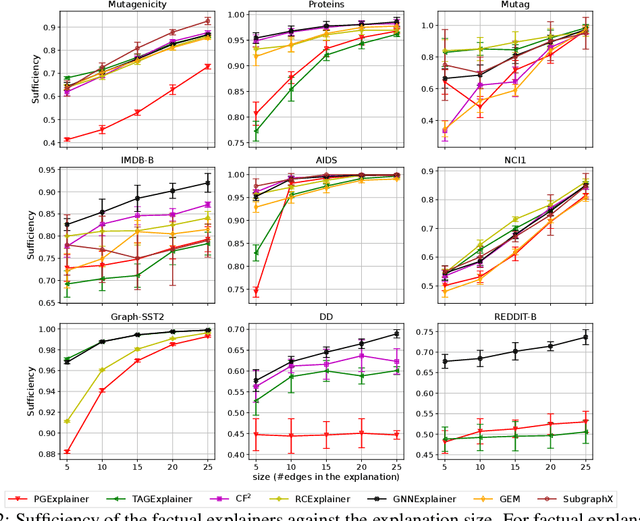
Abstract:Numerous explainability methods have been proposed to shed light on the inner workings of GNNs. Despite the inclusion of empirical evaluations in all the proposed algorithms, the interrogative aspects of these evaluations lack diversity. As a result, various facets of explainability pertaining to GNNs, such as a comparative analysis of counterfactual reasoners, their stability to variational factors such as different GNN architectures, noise, stochasticity in non-convex loss surfaces, feasibility amidst domain constraints, and so forth, have yet to be formally investigated. Motivated by this need, we present a benchmarking study on perturbation-based explainability methods for GNNs, aiming to systematically evaluate and compare a wide range of explainability techniques. Among the key findings of our study, we identify the Pareto-optimal methods that exhibit superior efficacy and stability in the presence of noise. Nonetheless, our study reveals that all algorithms are affected by stability issues when faced with noisy data. Furthermore, we have established that the current generation of counterfactual explainers often fails to provide feasible recourses due to violations of topological constraints encoded by domain-specific considerations. Overall, this benchmarking study empowers stakeholders in the field of GNNs with a comprehensive understanding of the state-of-the-art explainability methods, potential research problems for further enhancement, and the implications of their application in real-world scenarios.
Scaling Distributed Multi-task Reinforcement Learning with Experience Sharing
Jul 11, 2023
Abstract:Recently, DARPA launched the ShELL program, which aims to explore how experience sharing can benefit distributed lifelong learning agents in adapting to new challenges. In this paper, we address this issue by conducting both theoretical and empirical research on distributed multi-task reinforcement learning (RL), where a group of $N$ agents collaboratively solves $M$ tasks without prior knowledge of their identities. We approach the problem by formulating it as linearly parameterized contextual Markov decision processes (MDPs), where each task is represented by a context that specifies the transition dynamics and rewards. To tackle this problem, we propose an algorithm called DistMT-LSVI. First, the agents identify the tasks, and then they exchange information through a central server to derive $\epsilon$-optimal policies for the tasks. Our research demonstrates that to achieve $\epsilon$-optimal policies for all $M$ tasks, a single agent using DistMT-LSVI needs to run a total number of episodes that is at most $\tilde{\mathcal{O}}({d^3H^6(\epsilon^{-2}+c_{\rm sep}^{-2})}\cdot M/N)$, where $c_{\rm sep}>0$ is a constant representing task separability, $H$ is the horizon of each episode, and $d$ is the feature dimension of the dynamics and rewards. Notably, DistMT-LSVI improves the sample complexity of non-distributed settings by a factor of $1/N$, as each agent independently learns $\epsilon$-optimal policies for all $M$ tasks using $\tilde{\mathcal{O}}(d^3H^6M\epsilon^{-2})$ episodes. Additionally, we provide numerical experiments conducted on OpenAI Gym Atari environments that validate our theoretical findings.
Variance of Twitter Embeddings and Temporal Trends of COVID-19 cases
Sep 30, 2021



Abstract:The severity of the coronavirus pandemic necessitates the need of effective administrative decisions. Over 4 lakh people in India succumbed to COVID-19, with over 3 crore confirmed cases, and still counting. The threat of a plausible third wave continues to haunt millions. In this ever changing dynamic of the virus, predictive modeling methods can serve as an integral tool. The pandemic has further triggered an unprecedented usage of social media. This paper aims to propose a method for harnessing social media, specifically Twitter, to predict the upcoming scenarios related to COVID-19 cases. In this study, we seek to understand how the surges in COVID-19 related tweets can indicate rise in the cases. This prospective analysis can be utilised to aid administrators about timely resource allocation to lessen the severity of the damage. Using word embeddings to capture the semantic meaning of tweets, we identify Significant Dimensions (SDs).Our methodology predicts the rise in cases with a lead time of 15 days and 30 days with R2 scores of 0.80 and 0.62 respectively. Finally, we explain the thematic utility of the SDs.
WiseR: An end-to-end structure learning and deployment framework for causal graphical models
Aug 19, 2021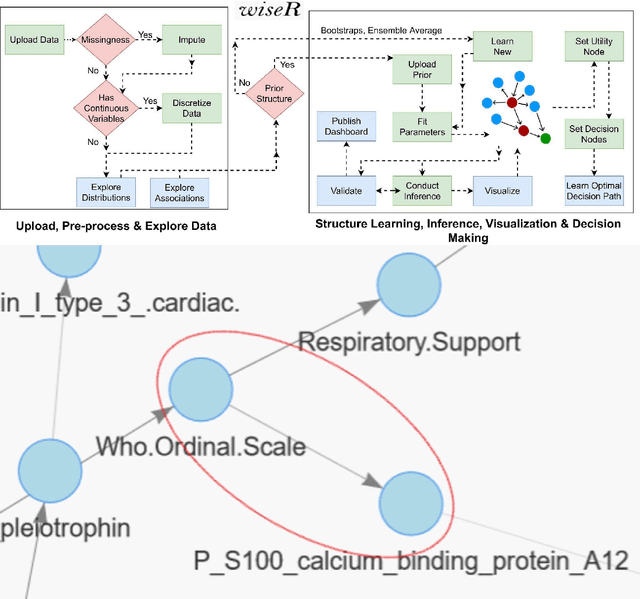
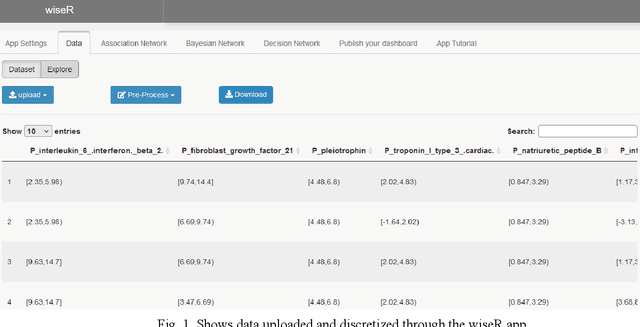
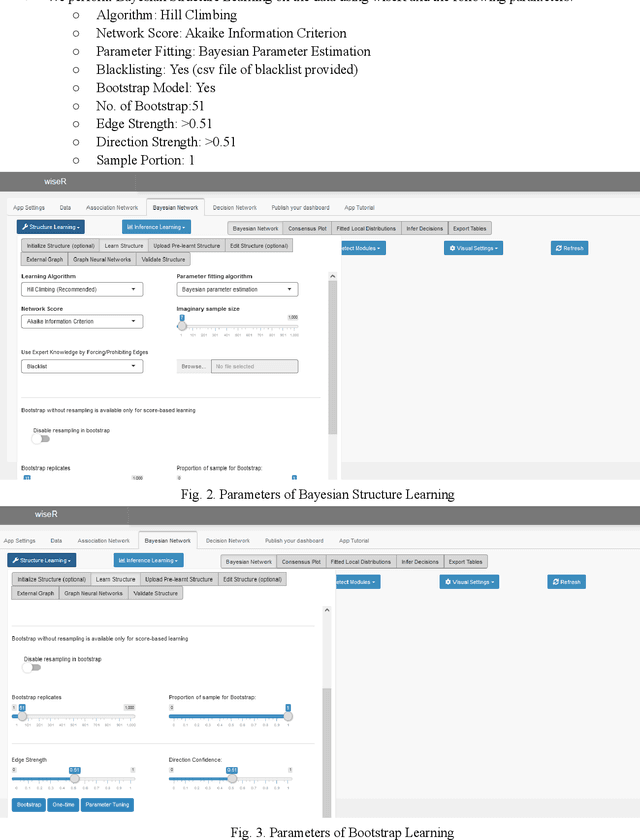
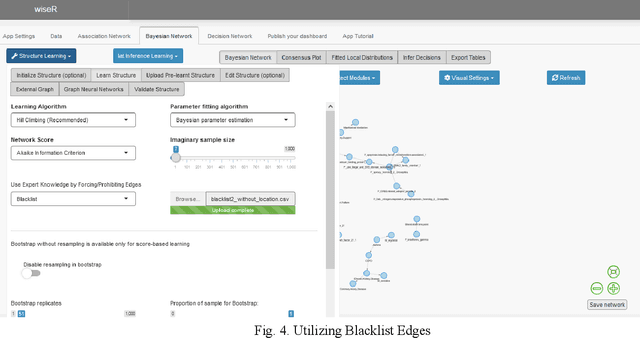
Abstract:Structure learning offers an expressive, versatile and explainable approach to causal and mechanistic modeling of complex biological data. We present wiseR, an open source application for learning, evaluating and deploying robust causal graphical models using graph neural networks and Bayesian networks. We demonstrate the utility of this application through application on for biomarker discovery in a COVID-19 clinical dataset.
 Add to Chrome
Add to Chrome Add to Firefox
Add to Firefox Add to Edge
Add to Edge